Sleep Training
How to Help Your Newborn Sleep Without Swaddling
Journey into a swaddle-free sleep routine with your newborn using gentle strategies and effective tips – discover how to navigate this transition seamlessly.
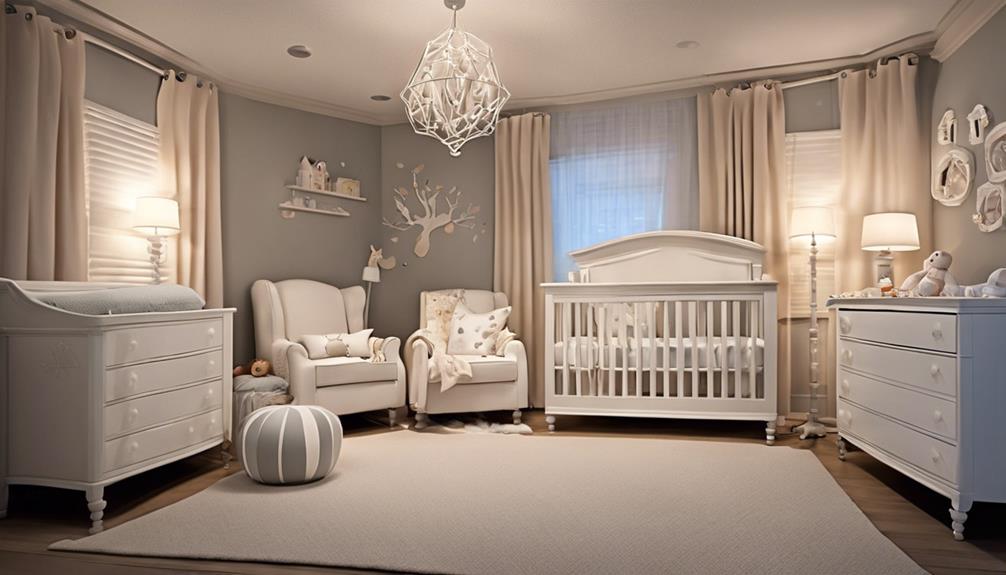
When it comes to getting your newborn to sleep without swaddling, it may seem like a daunting task at first. However, there are gentle techniques and strategies that can help with this transition.
By understanding your baby's signals and needs, as well as implementing some simple yet effective techniques, you can navigate this journey with confidence and success.
Let's explore some practical tips and suggestions that could make a significant difference in your little one's sleep routine.
Key Takeaways
- Gradually transition from swaddling to sleep sacks for comfort and movement.
- Establish a consistent bedtime routine to signal sleep time and promote better sleep patterns.
- Encourage self-soothing with pacifiers or security objects to aid in independent sleep.
- Ensure a cozy sleep environment with dim lights, optimal room temperature, and calming sounds for better sleep quality.
Transitioning Out of Swaddling Techniques
Moving out of wrapping can be a gentle process that helps your newborn adjust to sleeping without being tightly wrapped. To facilitate this shift, consider gradually loosening the wrap to accustom your baby to more freedom of movement.
Introducing a sleep sack can provide a cozy alternative to wrapping, ensuring warmth and comfort during sleep. Opt for high-quality sleep sacks to maintain a secure feeling similar to being wrapped.
Additionally, dressing your baby in warm pajamas can mimic the sensation of being wrapped, aiding in a smooth change. Encouraging self-soothing techniques such as offering a pacifier or introducing a comfort object can help your baby feel secure and calm without the need for wrapping.
Establishing a Cozy Sleep Environment

Creating a cozy sleep environment for your newborn is essential for promoting quality rest and fostering healthy sleep habits. When setting up the nursery for your baby, consider the following tips to guarantee a peaceful and conducive sleeping space:
- Dim the lights: Create a serene atmosphere by dimming the lights in the nursery to signal to your baby that it's time to sleep.
- Use blackout curtains: Block out external light sources with blackout curtains to help your baby stay asleep longer and improve sleep quality.
- Maintain room temperature: Keep the nursery comfortably cool, around 68-72°F, to prevent your baby from getting too hot or too cold during the night.
- Incorporate white noise: Mask background noises with white noise or calming music to soothe your newborn and promote restful sleep.
- Curate a calming environment: Design a peaceful nursery with soft colors, cozy bedding, and minimal distractions to create the perfect sleep sanctuary for your little one.
Consistent Bedtime Routine Importance

Establishing a consistent bedtime routine is important for signaling to your newborn that it's time to sleep, fostering better sleep patterns and habits.
A bedtime routine not only helps reduce bedtime battles but also aids in the change from swaddling, making it smoother for your baby.
Consistency in bedtime routines plays a vital role in regulating your newborn's internal clock, leading to more predictable sleep patterns.
Additionally, these routines create a sense of security and comfort for your baby, helping them relax and prepare for sleep without the need for swaddling.
By incorporating calming activities such as a warm bath, gentle massage, or soothing lullabies into the bedtime routine, you can promote relaxation and better sleep for your newborn.
Embracing a bedtime routine not only enhances your baby's sleep quality but also strengthens the bond between you and your little one, providing a nurturing environment for restful nights.
Self-Soothing Methods for Newborns
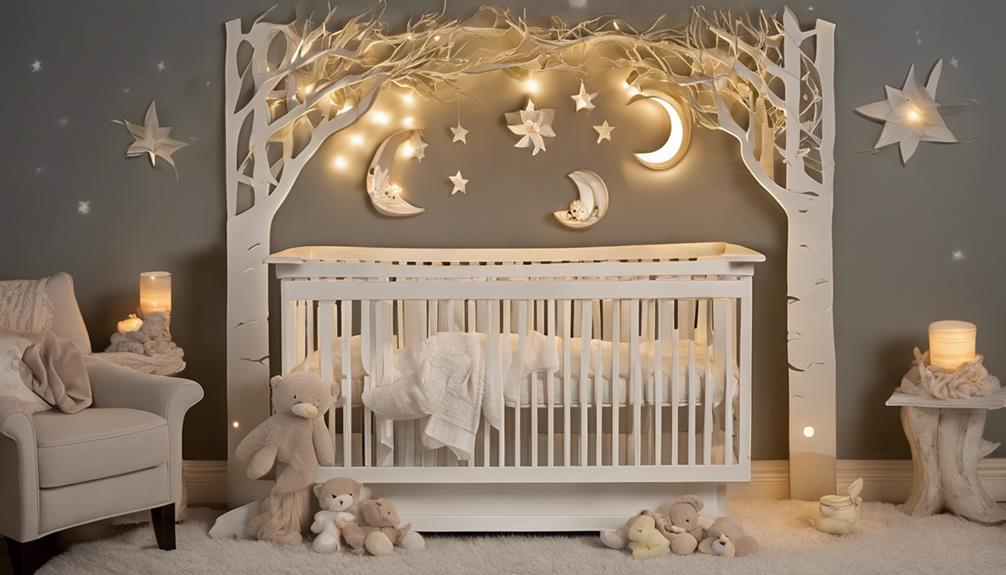
Let's discuss how we can help newborns develop self-soothing methods to promote better sleep habits. Here are some effective strategies to assist your newborn in self-soothing:
- Introduce a pacifier: Offering a pacifier can provide comfort and aid in self-soothing during sleep.
- Intermediate object: Providing a small blanket or stuffed animal can offer security and comfort to your newborn.
- Gentle rocking: Gentle rocking or swaying motions can help calm your baby and encourage better sleep habits.
- Consistent bedtime routine: Establishing a consistent bedtime routine signals to your newborn that it's time to sleep, promoting self-soothing behaviors.
- Calming environment: Using calming music or white noise machines can create a soothing atmosphere that helps your newborn sleep independently.
Exploring Alternative Sleep Positions

Experimenting with different sleep positions can be beneficial in helping your newborn find a comfortable and safe option for quality sleep without the need for swaddling. When exploring alternative positions, it's important to prioritize safe sleep by always placing your baby on their back. This position aligns with safe sleep guidelines and reduces the risk of Sudden Infant Death Syndrome (SIDS).
Observing how your newborn responds to various sleep positions is key to identifying the one that helps them relax and settle into sleep effectively.
To enhance your baby's comfort and sense of security, consider using sleep aids such as specialized sleep sacks or sleep bags. These can provide a cozy environment that mimics the feeling of being swaddled without restricting movement. Monitoring your baby's sleep patterns and behaviors will help you determine the most soothing position for them to achieve quality sleep.
How Can I Help My Newborn Sleep Better Without Swaddling if they are Sweating During Sleep?
If your newborn is sweating during sleep and you want to find alternative methods for helping your newborn sleep better without swaddling, you can try using lightweight, breathable sleeping clothes and covers, adjusting the room temperature, and creating a calming bedtime routine to promote better sleep without swaddling.
Conclusion
As we gently guide our newborns to sleep without swaddling, we're like the wind helping a fragile butterfly emerge from its cocoon.
By creating a peaceful sleep environment, establishing soothing routines, and teaching self-soothing techniques, we're nurturing our little ones to spread their wings and soar into dreamland.
Trust in the process, be patient, and watch as your baby blossoms into a confident sleeper. Sweet dreams await!
Nancy combines her love for writing with a deep understanding of the diverse dynamics of family life. As a parent, she brings personal experience and empathy to her work, covering topics from early childhood to the teenage years. Nancy’s work is driven by the belief that every family’s story is unique, and sharing these stories can inspire and support others on their parenting journey.
Sleep Training
Newborn Sleep Guide: Crib Safety Tips
Foster a safe sleep haven for your newborn with essential crib safety tips, but there's one crucial aspect you might not have considered…

As we navigate the complex world of newborn sleep, ensuring crib safety is like building a strong foundation for a peaceful night’s rest.
However, as we explore the nuances of creating a secure sleep environment for our little ones, a vital aspect often overlooked may surprise you.
Key Takeaways
- Place newborn on back on firm mattress to reduce SIDS risk.
- Avoid soft bedding, pillows, and toys in the crib.
- Regularly inspect crib for safety hazards like loose parts.
- Ensure spacing between crib slats is no more than 2 3/8 inches.
Safe Sleep Environment Recommendations
When creating a safe sleep environment for your newborn, it's important to follow these recommendations to reduce the risk of SIDS and maintain a secure sleeping space.
Placing the infant on their back on a firm crib mattress is important in minimizing the chances of SIDS, as recommended by experts. Using a tight-fitting bottom sheet specifically designed for cribs is essential to prevent entrapment hazards that could pose risks during sleep.
It's also advised to refrain from placing pillows, quilts, comforters, bumper pads, or stuffed toys in the crib to guarantee a clear and safe sleeping space for the baby. Positioning the baby with their feet towards the foot of the crib when using a blanket can further enhance safe sleep practices.
Additionally, checking that the spacing between crib slats is no more than 2 3/8 inches is crucial to prevent any potential entrapment issues. By adhering to these simple yet important recommendations, you can significantly reduce the risks associated with SIDS and create a secure sleeping environment for your precious little one.
Crib Safety Standards Overview

To assure the safety of your newborn while they sleep, understanding the crib safety standards established by the CPSC in 2011 is paramount. These guidelines set by the CPSC are stringent to guarantee infant safety.
Cribs manufactured after 2011 must comply with these CPSC standards for safety, emphasizing factors like smooth corner posts, securely attached hardware, and proper sizing. It's important to avoid cribs with drop-sides, cutouts in headboards or footboards, and any potential hazards that could pose a risk to your baby.
When selecting a crib for your newborn, remember to prioritize safety over aesthetics. While it's natural to want a visually appealing crib, ensuring it meets all safety standards is of utmost importance.
Setting Up the Crib Correctly

Setting up the crib correctly guarantees a safe sleeping environment for your newborn. To make sure crib safety and create a secure sleep space, there are key steps to follow when setting up your baby's crib. Here is a helpful guide to assist you in the crib setup process:
| Crib Safety Tips | Description |
|---|---|
| Firm Mattress | Use a firm mattress that fits snugly to reduce entrapment risks. |
| Secure Hardware | Check and tighten all hardware like screws and brackets to prevent hazards. |
| Safe Sleep Environment | Position the crib away from windows, cords, and curtains for a safe setting. |
| Regular Inspection | Regularly inspect the crib for wear, damage, or loose parts to address promptly. |
Common Crib Safety Mistakes

As parents, we must be aware of the common crib safety mistakes that can unknowingly put our newborns at risk. Keeping our little ones safe while they sleep is paramount, and avoiding these hazards is vital:
- Using Soft Bedding: Placing items like pillows, quilts, or stuffed toys in the crib may increase the risk of suffocation for infants. Opt for a firm mattress and fitted sheet instead.
- Bumper Pads: Despite their popularity, bumper pads can pose suffocation or strangulation hazards. It's best to keep the crib free of these items to ensure a safe sleep environment.
- Loose Bedding: Loose bedding not only increases suffocation risks but also poses entrapment hazards. Following safe sleep practices means keeping the crib bare and free of any potential obstructions.
Crib Safety Tips for Newborns

Investing in crib safety for newborns is crucial for creating a secure sleep environment. When putting your newborn down to rest, remember to always place them on their back to sleep to reduce the risk of Sudden Infant Death Syndrome (SIDS).
Opt for a firm, flat mattress in the crib without any soft bedding, pillows, or toys to promote a safe sleep space. Regularly inspect the crib for loose screws, missing hardware, or broken slats that could harm your newborn. Make sure the spacing between crib slats is no more than 2 3/8 inches to prevent entrapment.
It's essential to avoid using crib bumpers, blankets, or stuffed toys in the crib with your newborn, as these items can increase the risk of suffocation or entrapment. By following these crib safety tips, you can create a secure and comfortable environment for your newborn to sleep soundly.
Frequently Asked Questions
How Do I Make My Newborn Crib Safe?
To keep your newborn's crib safe, we guarantee a snug mattress, proper slat spacing, and secure hardware. Avoid cutouts in the headboard, footboard, or tall corner posts. Safety first for peaceful sleep!
Can a Newborn Safely Sleep in a Crib?
We absolutely can let newborns sleep safely in cribs! Following strict safety standards: firm mattress, tight sheet, no loose items. Back sleeping is a must, and regular crib checks are essential. Our little ones' safety is our top priority.
What Precautions Should Be Taken When Baby Is in Crib?
When baby is in the crib, we must place them on their back, confirm a firm mattress, and keep the crib bare. Precautions include avoiding pillows, quilts, bumper pads, or loose hardware to provide a safe sleep environment.
What Are the Safety Rules for Cribs?
We prioritize crib safety. Confirm slat spacing meets standards, corner posts are short, mattress fits snugly, all hardware is secure, and no cutouts are present. These measures prevent entrapment, suffocation, and strangulation risks.
Conclusion
In creating a safe sleep environment for our newborns, we lay the foundation for healthy sleep habits and peace of mind. Like a gentle lullaby, our attention to crib safety standards and practices creates a soothing rhythm for our little ones to rest peacefully.
Let's continue to prioritize their well-being by following these crib safety tips and ensuring a secure, comfortable sleeping space for our precious babies. Together, we can promote a safe and sound sleep for our newest family members.
Pamela is the voice behind our vibrant community, fostering connections and conversations among parents. Her expertise in community engagement and personal experiences as a parent fuel her passion for creating a supportive space for all. Pamela believes that community is crucial for navigating the complexities of parenting, offering a place for sharing, learning, and growing together.
Sleep Training
Why Should Newborns Wear a Hat to Sleep: Essential Guide
Safeguard your newborn's sleep with a simple hat – the key to unlocking surprising benefits you never knew about!

Let's shed light on why newborns wearing a hat to sleep is more than just a routine. The significance of this practice may surprise you, impacting not just their comfort but also their well-being.
The benefits of this simple accessory extend beyond mere fashion, offering a layer of protection that goes beyond what meets the eye. So, why should we consider this often-overlooked aspect of a baby's bedtime attire?
Key Takeaways
- Hats aid in regulating newborns' body temperature during sleep.
- Proper hat use prevents overheating and reduces SIDS risks.
- Hats offer security by mimicking swaddling effects for comfort.
- Monitoring temperature and room conditions is crucial for safe sleep practices.
Importance of Newborns Wearing Hats
Wearing hats to sleep is a practice that should be approached with caution for newborns due to the important role their heads play in regulating body temperature. Newborns have developing systems for controlling their body heat, and their heads are crucial in this process. Overheating, which can be caused by wearing a hat while sleeping, has been linked to an increased risk of Sudden Infant Death Syndrome (SIDS). Additionally, hats on newborns during sleep pose suffocation hazards as they may fall off and cover their faces.
Indoor hat wear for babies is generally unnecessary and can lead to overheating. It's advisable to dress newborns in light layers to make they stay comfortable without risking overheating. Monitoring a baby's hands, feet, and nose for coldness can help caregivers determine if additional layers are necessary instead of using a hat for sleep. By being mindful of these factors, we can promote safe and comfortable sleep environments for newborns.
Benefits of Hat-Wearing During Sleep

During sleep, newborns can benefit from wearing hats to help them retain body heat in cooler environments. Newborns have a larger head surface area-to-body ratio, making them more susceptible to heat loss through their heads. By wearing a hat, they gain an extra layer of warmth without the suffocation risk associated with blankets.
This additional warmth aids in regulating their body temperature, important for ensuring their comfort and well-being during sleep. Maintaining a stable body temperature through hat-wearing promotes better sleep quality for newborns. With hats, infants can better conserve heat, reducing the chances of waking up due to feeling cold.
These benefits not only enhance their sleep experience but also contribute to overall health and development. Incorporating hats into a newborn's sleep routine can be a simple yet effective way to provide them with the best conditions for rest and growth.
Temperature Regulation With Baby Hats
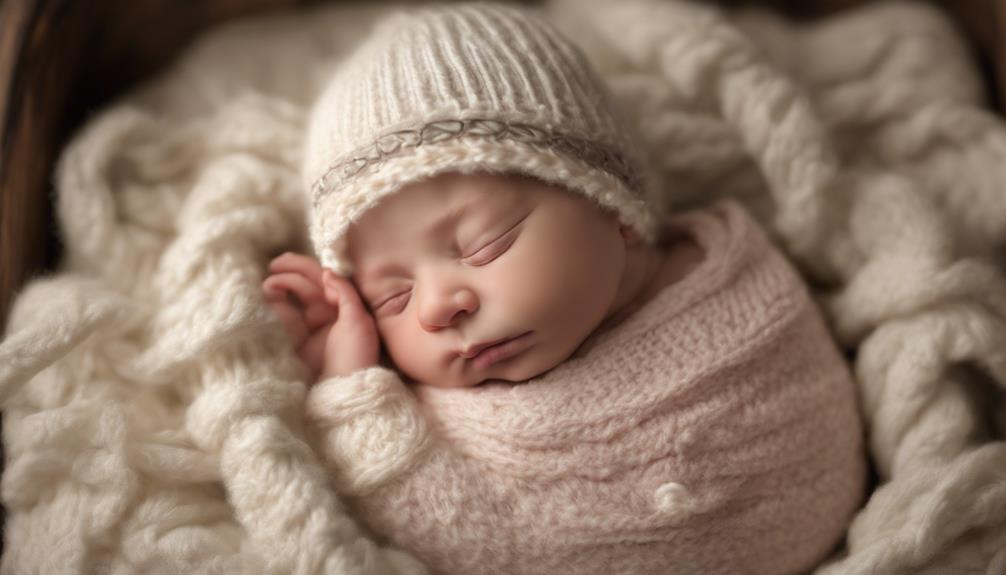
To guarantee ideal temperature regulation for newborns, it is vital to contemplate the impact of baby hats on their body heat management during sleep. Newborns regulate body temperature primarily through their heads, making it crucial not to cover their heads with hats while sleeping. Overheating caused by a hat can elevate the risk of SIDS (Sudden Infant Death Syndrome) in newborns. Additionally, hats worn during sleep may fall off and obstruct the baby's face, posing suffocation risks. Avoiding hats for newborns during sleep helps prevent overheating and enables natural body temperature regulation. Monitoring the baby's hands, feet, and nose for coldness serves as a better indicator for needing additional layers than relying on a hat for sleep.
| Aspect | Impact |
|---|---|
| Body Temperature | Regulated through the head; avoid covering with hats |
| Overheating | Increases SIDS risk; hats can lead to overheating |
| Suffocation Risks | Hats may fall off and cover the face during sleep |
| Monitoring | Check hands, feet, and nose for coldness instead |
| Additional Layers | Use indicators other than hats for additional layers |
Hat as a Security Aid for Newborns

Utilizing a soft, breathable hat made from natural materials can provide newborns with a comforting sense of security akin to being swaddled or held. When considering hats as a security aid for newborns, several factors come into play:
- Mimicking Swaddling: Hats can mimic the feeling of being swaddled, offering a gentle pressure that can help calm newborns and promote better sleep.
- Regulating Body Temperature: By preventing heat loss through the head, hats assist in regulating a newborn's body temperature, ensuring they stay cozy and comfortable throughout the night.
- Soothing Startle Reflex: Some newborns have a startle reflex that can disrupt their sleep; wearing a hat can provide a sense of security that soothes this reflex.
- Comfort with Soft, Breathable Materials: Opting for a hat made from soft, breathable natural materials enhances the overall comfort for newborns while they rest peacefully.
Enhancing Newborn Sleep With Hats

Enhancing newborns' sleep with hats can be a delicate balance between providing comfort and ensuring safety. While hats were traditionally thought to help regulate body temperature, research shows that newborns actually regulate temperature through their heads, making hats unnecessary for sleep. In fact, wearing hats during sleep can increase the risk of overheating and Sudden Infant Death Syndrome (SIDS). In addition, there is a suffocation risk if the hat falls off and covers the baby's face. To enhance newborn sleep without hats, monitoring the baby's temperature and room conditions is essential. Opt for dressing your baby in light layers of indoor clothing rather than hats to prevent overheating. By maintaining a comfortable room temperature and dressing your baby appropriately, you can promote safe and sound sleep without the need for a hat.
| Key Points | Recommendations |
|---|---|
| Body Temperature Regulation | Hats unnecessary for sleep |
| Sleep Safety | Avoid hats to reduce SIDS and overheating |
| Monitoring | Check room conditions for best sleep |
Frequently Asked Questions
Do Newborns Need to Sleep With a Hat?
We don't recommend newborns wear hats to sleep. Babies regulate body heat through their heads, and hats can lead to overheating or suffocation. Monitoring temperature and dressing in light layers are better practices for safe and comfortable sleep.
Why Is It Important for Newborns to Wear Hats?
Wearing hats to sleep is important for newborns as they lose heat through their heads, risking hypothermia. Hats maintain body warmth, offer protection, and create a cozy sleep environment. Keeping newborns snug with hats guarantees comfort and safety.
Should Newborns Wear Hats to Sleep in Hospital?
We recommend newborns wear hats to sleep in hospitals for warmth and comfort. Hats help regulate body temperature, prevent heat loss, and provide security. This common practice supports newborns' well-being and creates a cozy environment for rest.
How Should I Dress My Baby for Sleep Guide?
We dress our baby for sleep by adding one more layer than we wear, keeping the room at 68°-72°F. Overheating poses SIDS risks, so we prioritize safety over fashion. Skip hats to prevent overheating, prioritize easy diaper changes with functional sleepwear.
Conclusion
In summary, hats play a vital role in helping newborns regulate their body temperature and guarantee a safe and comfortable sleep environment.
Just like a cozy blanket wraps a baby in warmth and security, a hat can provide that extra layer of comfort and protection.
By understanding the benefits of hat-wearing for newborns, parents can make informed choices to support their little ones' well-being and promote healthy sleep habits.
Pamela is the voice behind our vibrant community, fostering connections and conversations among parents. Her expertise in community engagement and personal experiences as a parent fuel her passion for creating a supportive space for all. Pamela believes that community is crucial for navigating the complexities of parenting, offering a place for sharing, learning, and growing together.
Sleep Training
The Best Way for a Newborn to Sleep Through the Night
Lullabies, swaddling, or white noise – discover the key to helping your newborn sleep through the night effortlessly.

Coincidentally, we've all experienced those sleepless nights with a newborn. But have you ever wondered what the best approach is to help them sleep through the night?
Well, let's explore some proven strategies and techniques that can make a real difference in establishing healthy sleep habits for your little one. From setting up a calming bedtime routine to maneuvering through those challenging growth spurts, there are key steps you can take to promote better sleep for your newborn.
Let's uncover the secrets to a restful night for both you and your baby.
Key Takeaways
- Establish a consistent bedtime routine early for peaceful sleep.
- Teach self-soothing techniques to promote independent sleep habits.
- Gradually reduce night feedings to encourage longer sleep stretches.
- Create a calming sleep environment with optimal conditions for rest.
Establishing a Consistent Bedtime Routine
To help your newborn sleep through the night, starting a simple bedtime routine early is key. Importance is essential in setting the stage for a restful night's sleep for your baby. By incorporating calming activities such as swaddling and gentle shushing sounds into your bedtime routine, you can help your little one relax and prepare for sleep. These soothing rituals create positive sleep associations, signaling to your baby that it's time to wind down and rest.
Paying close attention to your baby's tired cues is vital to prevent them from becoming overtired, which can make it more challenging for them to settle down and sleep soundly. Responding promptly to these cues can help your baby relax and ease into bedtime more smoothly. Remember, a relaxed and comfortable baby is more likely to drift off to sleep peacefully. So, swaddle your baby snugly, play some soft music, and let the calming routine guide them into dreamland.
Teaching Self-Soothing Techniques

Encouraging newborns to develop self-soothing skills involves allowing them to independently settle themselves to sleep without constant intervention. This process helps them learn to fall back asleep on their own, reducing the need for external soothing during night wakings. To facilitate this learning, gently weighted products such as swaddles or sleep sacks can provide a sense of security for the baby, aiding in self-soothing behaviors.
Additionally, gradually reducing nighttime feedings can help break the feeding association with falling back asleep, encouraging the baby to self-soothe during the night.
- Use gently weighted products like swaddles or sleep sacks to help baby self-soothe.
- Limit soothing interventions during night wakings to promote self-soothing skills.
- Gradually reduce nighttime feedings to break the association between feeding and falling back asleep, promoting self-soothing.
Gradual Night Feeding Weaning
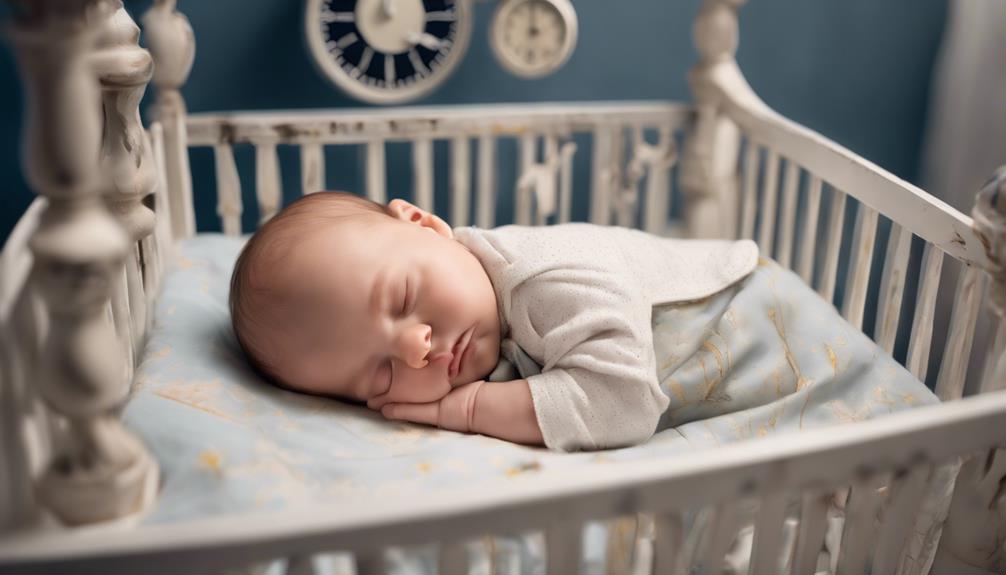
When helping newborns learn to self-soothe, gradually reducing night feedings can be a vital way to encourage longer stretches of sleep without disrupting their feeding schedule. Before starting this process, it's important to consult your doctor to make sure it aligns with your baby's age and health needs.
Slowly spacing out night feedings allows the baby to adjust to more extended periods without feeding, aiding in promoting better sleep patterns. By breaking the association between feeding and sleep, you can offer comfort through gentle rocking or soothing sounds instead.
Introducing dream feeds before your bedtime can make sure your baby receives sufficient nutrition and potentially sleeps longer stretches without needing a feeding. Consistent implementation of gradual night feeding weaning can help your baby learn to self-soothe and become more independent in their sleep, leading to longer, uninterrupted nights for both you and your little one.
Creating a Calming Sleep Environment

Maintaining a comfortable room temperature between 68-72°F is essential for peak sleep in newborns. Darkness is key, so blackout curtains or shades can help block out light and create a conducive sleep environment. White noise machines or fans provide consistent auditory stimulation, masking background noises for better sleep.
It's important to avoid bright lights or screens before bedtime to signal to the baby that it's time to sleep. Establishing a consistent bedtime routine that includes calming activities such as swaddling and gentle rocking can promote relaxation and help the baby ease into sleep.
Patience and Persistence in Sleep Training
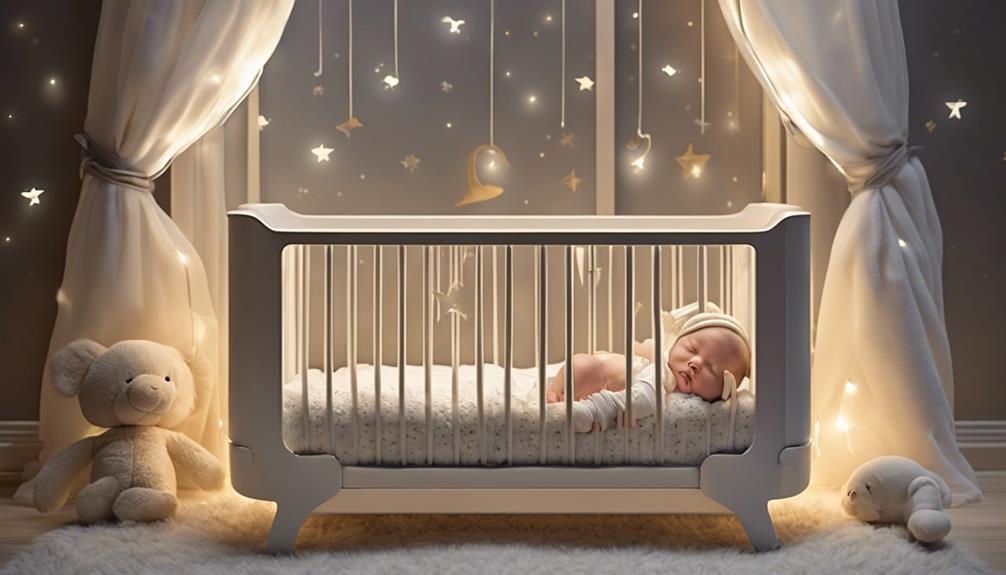
To help your newborn develop healthy sleep habits, patience and persistence play a significant role in sleep training. Consistency in bedtime routine and approach is important for successful sleep training. Gradually reducing nighttime feedings can assist babies in learning to sleep through the night.
Implementing self-soothing techniques can help promote independent sleep habits. Remember that adjusting to a new sleep schedule may take a few weeks for babies. Patience is key during this process. It's normal for babies to struggle with sleep training, but persistence is important for long-term success.
Frequently Asked Questions
How Do I Get My Newborn to Sleep Through the Night?
I empathize with the struggle of getting a newborn to sleep through the night. Consistency in routine, frequent feedings, creating a soothing environment, and swaddling can all help establish healthy sleep patterns. Remember, every baby is different.
At What Age Do Newborns Sleep Through the Night?
As parents, we comprehend the longing for uninterrupted sleep. Newborns usually start sleeping longer stretches around 2-3 months. Each baby is unique, so their ability to sleep through the night varies. Patience and consistency are key.
Can You Train a Newborn to Sleep Through the Night?
We believe newborns should not be trained to sleep through the night. Their tiny stomachs need frequent feedings for growth. Responding to cues, meeting nutritional needs, and promoting healthy development are crucial, rather than forcing adult sleep patterns.
Can You Let Newborn Sleep for 5 Hours?
Yes, we can let a newborn sleep for 5 hours. However, it's important to balance rest with feeding. Monitoring their sleep patterns and ensuring regular feedings every 3-4 hours at night is essential for their health and growth.
Conclusion
To sum up, helping your newborn sleep through the night is like planting a seed and watching it grow into a beautiful flower.
By establishing a consistent bedtime routine, teaching self-soothing techniques, and creating a calming sleep environment, you're nurturing healthy sleep habits that will blossom over time.
Remember, patience and persistence are key as you guide your little one towards longer stretches of peaceful slumber.
Trust the process and enjoy the sweet rewards of a well-rested baby.
Pamela is the voice behind our vibrant community, fostering connections and conversations among parents. Her expertise in community engagement and personal experiences as a parent fuel her passion for creating a supportive space for all. Pamela believes that community is crucial for navigating the complexities of parenting, offering a place for sharing, learning, and growing together.
-

 Third Trimester2 weeks ago
Third Trimester2 weeks agoManaging Nausea in the Third Trimester: A How-To Guide
-

 Third Trimester1 week ago
Third Trimester1 week agoManaging Nausea During the Third Trimester: A How-To Guide
-

 Third Trimester2 weeks ago
Third Trimester2 weeks agoSafe Third Trimester Exercise Guide for Moms-to-Be
-

 First Trimester3 months ago
First Trimester3 months agoDramamine Use in Pregnancy: First Trimester Guide
-

 Newborn Care6 hours ago
Newborn Care6 hours agoNewborn Care Basics: A Step-by-Step Guide
-

 Second Trimester3 months ago
Second Trimester3 months ago10 Common Causes of Dizziness in the Second Trimester
-

 Finding Time for Self2 months ago
Finding Time for Self2 months agoSelf-Care Tips for Single Parents | Make Time for You
-

 Finding Time for Self2 months ago
Finding Time for Self2 months agoSelf-Care for Stay-at-Home Moms: Making Time














